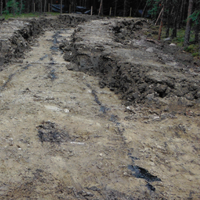Restrictions on HPCSS
 Today the AER published a report on their investigation into the flow to surface problems at CNRL Primrose. Primrose had five reported locations where bitumen emulsion flowed to surface. The flows were not restricted to old wellbores but also seeped through poor cap rock seal due to natural and induced fractures. Mostly the AER blames salt dissolution under the bitumen formation for weakening upper strata.
Today the AER published a report on their investigation into the flow to surface problems at CNRL Primrose. Primrose had five reported locations where bitumen emulsion flowed to surface. The flows were not restricted to old wellbores but also seeped through poor cap rock seal due to natural and induced fractures. Mostly the AER blames salt dissolution under the bitumen formation for weakening upper strata.
In their briefing to the media today, the AER said that CNR had been operating within their approval limits and the company has not been charged. However, injection restrictions were placed on some areas of Primrose. These restrictions include restricting some areas to low pressure CSS. But the regulator has further restricted areas within a kilometer of the flow to surface events to very low pressure hydrostatic pressure steam flooding.
The AER confirmed that restrictions in Primrose do not affect other operations by the CNR or by any other operator. Nevertheless, the mindset of the regulator has certainly been altered by these incidents. For example, there are new regulations requiring review of abandoned well integrity within ER Schemes.
Each AER application contains your neighbor's perspective on the exploitation of oil and gas formations. Applications contain more technical data even than SPE papers.
Can we help you review your steam schemes for similar potential concerns? AppIntel and Proven Reserves can help.
Subscribers can view this application by pasting the following link into their browser after logging into AppIntel. http://app.appintel.info/AOW.php?pxnrg=34617o3137313631383436396y
Not an AppIntel subscriber yet? May we set a demo to show you how it works?
Tags: Thermal, Heavy Oil
 Granger Low 21 Mar 2016
Granger Low 21 Mar 2016

Surprise! Sour gas production from a sweet thermal scheme
Dealing with surprises in the oil and gas industry. What to do next.

10 ways to increase production before Christmas - Infographic
For your wall to remind you

10 ways to increase production before Christmas
Each cost less than half a million

Using AI to reduce risk of oil and gas failure
How can you assess the risk without knowing the epic fails?

Artificial intelligence using vetted oil and gas information
Using anything else is dangerous

Your AI search history is being sold to your competitors
Your use of AI is not free




 Calgary, Alberta, Canada
Calgary, Alberta, Canada
 Share
Share